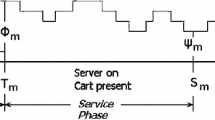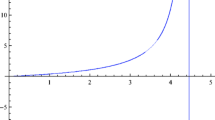Abstract
A Markovian queue, with both batch arrivals and batch departures, is first shown to have a geometric queue length probability distribution at equilibrium under certain conditions. From this a product-form solution follows directly for networks of such queues at equilibrium, by application of the reversed compound agent theorem (RCAT). The method is illustrated using small batches of sizes 1 and 2, as well as geometric sizes.
Access this chapter
Tax calculation will be finalised at checkout
Purchases are for personal use only
Similar content being viewed by others
Notes
- 1.
This is because the special departures are active transitions, with the empty queue as their only possible destination-state, whereas RCAT requires all states to be possible destinations [8]. Similarly, the special arrivals are passive but enabled only in the empty queue, i.e. not in every state, as required by RCAT. One could consider the special departures as passive and the special arrivals as active, provided they could occur in, or lead to, every state, respectively. However, a special arrival transition from the empty state to itself would then be required – i.e. an active “invisible transition”. This would lead to an increased rate of special departures in the synchronising queue, changing the model’s specification. Worse still, the special arrival rates would have to be carefully chosen (geometrically) so as to ensure constant reversed rates. Similarly, an invisible, passive, special departure transition would also be needed on the empty state, allowing spontaneous special arrivals at the synchronising queue, which again would probably not be wanted.
- 2.
We exclude feedback from a node to itself, so that \(j \ne i\) or, equivalently, we can define \(p_{ikjl}=0\) whenever \(i=j\).
References
Marin, S.B.A., Harrison, P.G.: Analysis of stochastic petri nets with signals. Perform. Eval. 69, 551–572 (2012)
Balsamo, S., Harrison, P.G., Marin, A.: Methodological construction of product-form stochastic petri nets for performance evaluation. J. Syst. Softw. 85, 1520–1539 (2012)
Baskett, F., Chandy, K.M., Muntz, R.R., Palacios, F.G.: Open, closed and mixed networks of queues with different classes of customers. J. ACM 22(2), 248–260 (1975)
Chao, X., Miyazawa, M., Pinedo, M.: Queueing Networks: Customers, Signals and Product Form Solutions. Wiley, New York (1999)
Gelenbe, E.: G-networks with triggered customer movement. J. Appl. Prob. 30, 742–748 (1993)
Gross, D., Harris, C.M.: Fundamentals of Queueing Theory. Wiley, New York (1985)
Harrison, P.G., Hayden, R.A., Knottenbelt, W.J.: Product-forms in batch networks: approximation and asymptotics. Perform. Eval. 70(10), 822–840 (2013)
Harrison, P.G.: Turning back time in Markovian process algebra. Theoret. Comput. Sci. 290(3), 1947–1986 (2003)
Harrison, P.G.: Compositional reversed Markov processes, with applications to G-networks. Perform. Eval. 57, 379–408 (2004)
Harrison, P.G.: Turning back time - what impact on performance? Comput. J. 53(6), 860–868 (2010)
Harrison, P.G., Patel, N.M.: Performance Modelling of Communication Networks and Computer Architectures. Addison-Wesley, Boston (1992)
Jackson, J.R.: Jobshop-like queueing systems. Manag. Sci. 10(1), 131–142 (1963)
Kelly, F.P.: Reversibility and Stochastic Networks. Wiley, New York (1979)
Mitrani, I., Chakka, R.: Spectral expansion solution for a class of Markov models: application and comparison with the matrix-geometric method. Perform. Eval. 23, 241–260 (1995)
Papathanasiou, A.E., Scott, M.L.: Energy efficiency through burstiness. In: 5th IEEE Workshop on Mobile Computing Systems and Applications (2003)
Author information
Authors and Affiliations
Corresponding author
Editor information
Editors and Affiliations
Rights and permissions
Copyright information
© 2018 Springer Nature Switzerland AG
About this paper
Cite this paper
Harrison, P.G. (2018). Product-Form Queueing Networks with Batches. In: Bakhshi, R., Ballarini, P., Barbot, B., Castel-Taleb, H., Remke, A. (eds) Computer Performance Engineering. EPEW 2018. Lecture Notes in Computer Science(), vol 11178. Springer, Cham. https://doi.org/10.1007/978-3-030-02227-3_17
Download citation
DOI: https://doi.org/10.1007/978-3-030-02227-3_17
Published:
Publisher Name: Springer, Cham
Print ISBN: 978-3-030-02226-6
Online ISBN: 978-3-030-02227-3
eBook Packages: Computer ScienceComputer Science (R0)




